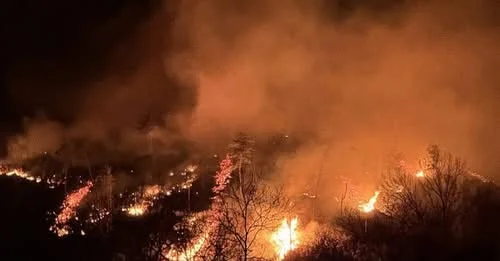South Korea Faces Worst Wildfires in History as Death Toll Rises and Fires Spread

South Korean authorities have declared the ongoing wildfires the worst in the country’s history, with the death toll climbing to 26 as the affected area continues to grow. The wildfires, which began on Friday in Sancheong county, Northern Gyeongsang province, have now scorched over 81,500 acres (33,000 hectares) of land more than double the area affected just a day earlier. This marks a severe escalation from the previous record for the largest wildfire, which burned 59,000 acres in 2000.
“We are in a national crisis,” said South Korea’s acting President Han Duck-soo during a government response meeting. He described the situation as being critical due to the unprecedented speed with which the fires have spread, particularly across mountainous regions in the southeast, fueled by dry winds.
The fires have impacted multiple regions, including Gyeongbuk, Uiseong, Andong, Cheongsong, Yeongyang, and Sancheong. Over 120 helicopters have been deployed to battle the blazes, but with strong winds and little rainfall expected, containment remains a significant challenge. The meteorological agency has forecasted light rain, but experts warn that it will likely not provide enough relief to extinguish the flames.
The fires have caused significant loss of life, with four firefighters and government workers dying in Sancheong county after being trapped by the flames. A pilot was also killed when his helicopter crashed while attempting to contain a blaze in Uiseong. Nearly 30,000 people have been evacuated as fires continue to ravage homes and businesses across several regions.
The fires have also caused extensive damage to cultural heritage sites. Half of the Gounsa Buddhist temple in Uiseong county, originally built in the seventh century, has been engulfed by flames. Among the buildings damaged are two state-designated treasures: a pavilion from 1668 and a structure from the Joseon Dynasty built in 1904.
Authorities have also issued an emergency alert for the Hahoe Folk Village in Andong county, a UNESCO-listed World Heritage Site, as the fire nears the area.
Investigations suggest that human error may have contributed to the fires, with possible causes including the burning of overgrown grass around family tombs or sparks from welding equipment. In addition, the region has experienced significantly lower-than-average rainfall this season, further exacerbating the situation.
As the country battles the largest wildfire in its history, South Korean officials continue to work tirelessly to contain the flames and assist affected residents, though the challenges remain immense.





